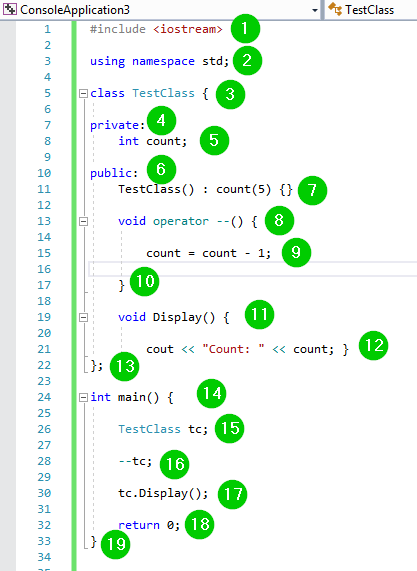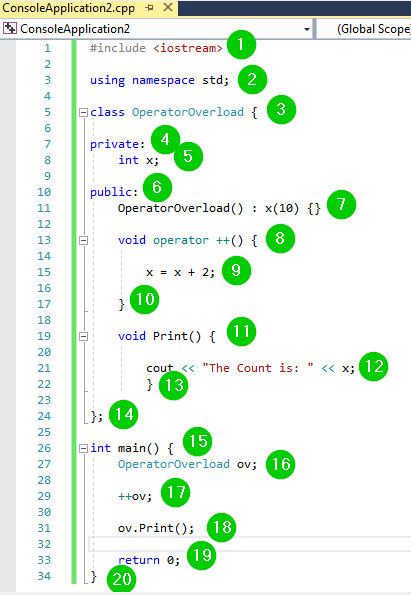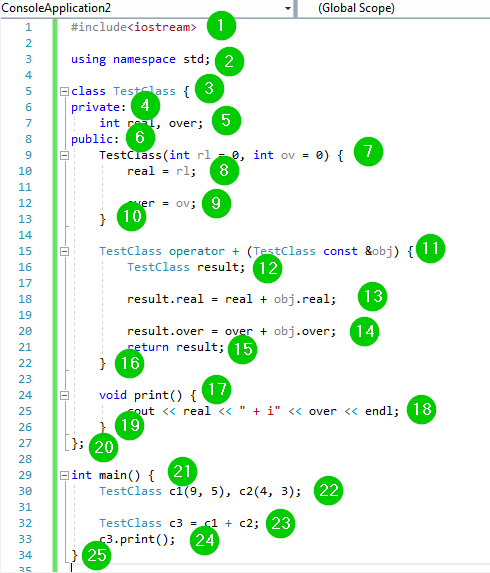C++ Operator Overloading with Examples
What is Operator Overloading?
Using operator overloading in C++, you can specify more than one meaning for an operator in one scope. The purpose of operator overloading is to provide a special meaning of an operator for a user-defined data type.
With the help of operator overloading, you can redefine the majority of the C++ operators. You can also use operator overloading to perform different operations using one operator.
Syntax
To overload a C++ operator, you should define a special function inside the Class as follows:
class class_name
{
... .. ...
public
return_type operator symbol (argument(s))
{
... .. ...
}
... .. ...
};
Here is an explanation for the above syntax:
- The return_type is the return type for the function.
- Next, you mention the operator keyword.
- The symbol denotes the operator symbol to be overloaded. For example, +, -, <, ++.
- The argument(s) can be passed to the operator function in the same way as functions.
Example 1
#include <iostream>
using namespace std;
class TestClass {
private:
int count;
public:
TestClass() : count(5) {}
void operator --() {
count = count - 3;
}
void Display() {
cout << "Count: " << count; }
};
int main() {
TestClass tc;
--tc;
tc.Display();
return 0;
}
Output:
Here is a screenshot of the code:
Code Explanation:
- Including the iostream header file in our code to use its functions.
- Include the std namespace in our program to use its classes without calling it.
- Create a class named TestClass.
- Use the private access modifier, which marks a class member as privately accessible.
- Create an integer variable count. This variable will be privately accessible.
- Use the public access modifier, which marks a class member as privately accessible.
- Use a class constructor to initialize the variable counter to 5.
- Overload the meaning of the — operator.
- The operator will decrement the value of the variable x by 1.
- End of the operator overloading section. The operator has been given a new name.
- Defining a function named Display() function.
- Print the value of variable count alongside other text on the console when the Display() function is called. The } marks the end of the body of Display() function.
- End of the class body.
- Call the main() function. The program logic should be added within this function.
- Create an instance of the class TestClass and give it the name tc.
- This will call the void operator –() function.
- Use the stance of TestClass Class to call the Display() function.
- The function must return value upon successful completion.
- End of the body of the function main().
Different Approaches to Operator Overloading in C++
You can perform operator overloading by implementing any of the following types of functions:
- Member Function
- Non-Member Function
- Friend Function
- The operator overloading function may be a member function when a Left operand is an object of the Class.
- When the Left operand is different, the Operator overloading function should be a non-member function.
You can make the operator overloading function a friend function if it needs to access the private and protected class members.
Can all C++ Operators be Overloaded?
No. There are C++ operators that can’t be overloaded.
They include:
- :: -Scope resolution operator
- ?: -ternary operator.
- . -member selector
- Sizeof operator
- * -member pointer selector
Things to Remember
- With operator overloading, you can redefine the way an operator works only for the user-defined types (objects, structures). You cannot use it for built-in types (float, char, int, etc.).
- The = and & C++ operators are overloaded by default. For example, you can copy the objects of the same Class directly using the = operator.
- Operator precedence doesn’t change the associatively and precedence of operators. However, you can change the order of evaluation using parenthesis.
- There are four operators that you cannot overload in C++. They include the scope resolution operator (::), member selection operator (.), member selection through a pointer to function operator (.*), and the ternary operator (?:).
Rules for Operator Overloading
Here are rules for Operator Overloading:
- For it to work, at least one operand must be a user-defined class object.
- You can only overload existing operators. You can’t overload new operators.
- Some operators cannot be overloaded using a friend function. However, such operators can be overloaded using member function.
How to Overload Operator
Example 1
#include <iostream>
using namespace std;
class OperatorOverload {
private:
int x;
public:
OperatorOverload() : x(10) {}
void operator ++() {
x = x + 2;
}
void Print() {
cout << "The Count is: " << x;
}
};
int main() {
OperatorOverload ov;
++ov;
ov.Print();
return 0;
}
Output:
Here is a screenshot of the code:
Code Explanation:
- Including the iostream header file in our code to use its functions.
- Include the std namespace in our program to use its classes without calling it.
- Create a class named OperatorOverload.
- Use the private access modifier, which marks a class member as privately accessible.
- Create an integer variable x. This variable will be privately accessible.
- Use the public access modifier, which marks a class member as privately accessible.
- Use a class constructor to initialize variable x to 10.
- Overload the meaning of the ++ operator.
- The operator will increment the value of variable x with 2.
- End of the operator overloading section. The operator has been given a new name.
- Calling the Print() function.
- Print the value of variable x alongside other text on the console when the Print() function is called.
- End of the body of the Print() function.
- End of the class body.
- Call the main() function. The program logic should be added within this function.
- Create an instance of the OperatorOverload Class named ov.
- This will call the void operator ++() function.
- Use the stance of OperatorOverload class to call the Print() function.
- The function must return value upon successful completion.
- End of the body of the function main().
Example 2
#include<iostream>
using namespace std;
class TestClass {
private:
int real, over;
public:
TestClass(int rl = 0, int ov = 0) {
real = rl;
over = ov;
}
TestClass operator + (TestClass const &obj) {
TestClass result;
result.real = real + obj.real;
result.over = over + obj.over;
return result;
}
void print() {
cout << real << " + i" << over << endl;
}
};
int main()
{
TestClass c1(9, 5), c2(4, 3);
TestClass c3 = c1 + c2;
c3.print();
}
Output:
Here is a screenshot of the code:
Code Explanation:
- Including the iostream header file into our program in order to use its functions.
- Include the std namespace into our program in order to use its classes without calling it.
- Create a class named TestClass. The { marks the beginning of the class body.
- Use the private access modifier to mark variables as private, meaning they can only be accessed from within the Class.
- Define two integer variables, real and over.
- Use the public access modifier to mark the constructor as public, meaning that it will be accessible even outside the Class.
- Creating the class constructor and initializing the variables.
- Initialize the value of variable real.
- Initialize the value of the variable over.
- End of the constructor body.
- Override the meaning of the + operator.
- Create the data type result of type TestClass.
- Use the + operator with complex numbers. This line will add the real part of a number to the real part of another number.
- Use the + operator with complex numbers. This line will add the imaginary part of a number to the imaginary part of another number.
- The program will return the value of the variable result upon successful execution.
- End of the definition of the new meaning of + operator, that is, overloading.
- Call the print() method.
- Print the new complex number after addition on the console.
- End of the body of print() function.
- End of the body of TestClass Class.
- Calling the main() function.
- Passing the values of both real and complex parts to be added. The first part of c1 will be added to the first part of c2, that is, 9+4. The second part of c1 will be added to the second part of c, that is, 5+3.
- Performing an operation using the overloaded + operator and storing the result in variable c3.
- Printing the value of variable c3 on the console.
- End of the body of main() function.
Summary
- You can specify more than one meaning for a C++ operator in one scope.
- This is called operator overloading.
- Operator overloading provides a special meaning of an operator for a user-defined data type.
- You can redefine the majority of C++ operators through operator overloading.
- Not all C++ operators can be overloaded.
- For an operator to be overloaded, at least one of the operands must be a user-defined object.
- Only existing operators can be overloaded. You cannot overload new operators.



